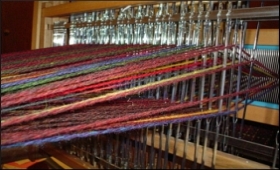|

|
Is Indian handloom dying a slow death?
|
|

|
|
| Top Stories |
 |
|
|
|
Nivedita Sharma | 14 Dec, 2011
Their handspun silks and cottons are sold for thousands and sometimes hundreds of thousands of rupees and top names endorse their products. But the humble hands that weave classy, elegant fabrics that the world admires are living in penury.
The soft rustle of kanjivaram, pochampalli, benarasi and chanderi silk saris can jazz up any wedding or party, but very few know that the centuries-old art behind them is dying a slow death because weavers are unable to make ends meet. The number of India's handloom weavers is on the decline as low remuneration and rising costs are making traditional worker look to other trades.
The average weaver, it is said, gets a maximum per day wage of Rs.250. The government has woken up to their problems, but many are asking if it is too little too late.
"With a sudden spurt in inflation and a sea change in standards of living, it is impossible to sustain handloom weavers even with government subsidies and various welfare schemes," K. Selvaraju, secretary general of The Southern India Mills' Association, told reporter.
"About 29.09 lakh (more than 2.9 million) weavers reportedly worked in the handloom sector as per the Handloom Census of India 2009-10, but in 1995-1996, 34.71 lakh (more than 3.47 mn) were involved. It shows a 16 percent reduction in 15 years. It is essential to come out with a constructive and comprehensive proposal for this heritage sector's survival," Selvaraju added.
Uttar Pradesh, West Bengal, Andhra Pradesh, Madhya Pradesh and Tamil Nadu are some of the states which are keeping the weaving tradition alive.
Commerce and Industry Minister Anand Sharma recently announced that the government would issue weaver credit cards, interest subsidy, credit guarantee and freight reimbursement.
In the budget for the current financial year, the government also announced a loan waiver package of Rs.3,000 crore, which was expected to benefit 15,000 handloom weaver cooperative societies and 300,000 handloom weavers, who had been unable to repay their loan on account of economic difficulties.
Selvaraju, however, is skeptical.
"The schemes offered by state and central governments for the handloom sector need to be re-looked and funds for the purpose should be utilised properly to encourage value addition, upskilling, productivity improvement, cost-effective manufacturing etc.," said Selvaraju.
At least two months of hard work are needed to produce a simple tassar silk sari, Kalyan Singh Rawat, a weaver from Andhra Pradesh, told reporter at an event in New Delhi.
"It requires very minute detailing and it takes us around two months to ready it. During that time we cannot be allowed to do other stuff and it affects our family," he added.
Ram Kumar, a weaver from West Bengal, says the demand is low; hence they are forced to produce a limited stock. He also rues that the middle man pockets the maximum profit.
"People are very specific in terms of design and style; hence handloom textiles don't attract them much. So, we either make garments inspired by Western designs or wait for the stock to finish. It's always the middle man who gets profit and we end up getting less wages," Kumar said.
Weavers are leading a difficult life and the situation will not change until the handloom sector is revamped, says Priyal Singha of the Handloom Weavers Development Association.
"The Handloom Reservation Act needs a complete makeover. Today a majority of the items covered under this act are made by the decentralised powerloom sector. Though the government tried its level best to prevent the powerloom sector from producing such varieties, they failed to enforce the same," Singha said who works with about 200 weavers.
"Also, the number of households using these products have reduced - from 25.25 lakh households in 1995 to 22.68 lakh households in 2011. Unless the government comes out with realistic and constructive proposals, it's impossible to achieve a sustained growth rate of the sector," he added.
For handloom revivalist Madhu Jain, one of the ideal ways to save the dying heirloom, is to revive it in a modern way to match the tastes of today's generation.
"It's very unfortunate to see that Indian designers have shifted their focus towards Western garments. It is the responsibility of people with high aesthetics to bring back a proud tradition," Jain said.
(Nivedita Sharma can be contacted at nivedita.s@ians.in)
|
|
|
| |
|
|
|
|
|
|
|
|
|
|
|
|
|
|
| |
| Customs Exchange Rates |
| Currency |
Import |
Export |
US Dollar
|
84.35
|
82.60 |
UK Pound
|
106.35
|
102.90 |
Euro
|
92.50
|
89.35 |
| Japanese
Yen |
55.05 |
53.40 |
| As on 12 Oct, 2024 |
|
|
| Daily Poll |
 |
 |
| Do you think Indian businesses will be negatively affected by Trump's America First Policy? |
|
|
|
|
|
| Commented Stories |
 |
|
|
|
|
|
| |
|